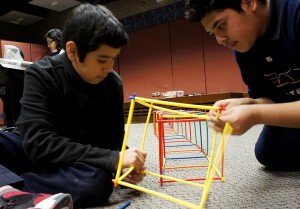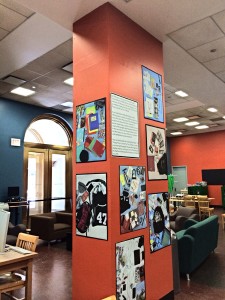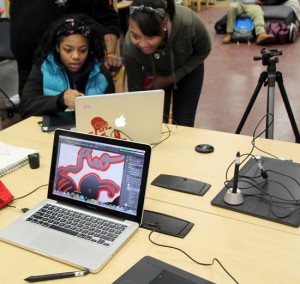Chicago Public Library to Expand YOUmedia Labs with Additional $2.5 Million
The Chicago Public Library will open and staff six more YOUmedia teen spaces this summer, along with temporary “pop-ups” in 12 branches, thanks to an additional $2 million from the MacArthur Foundation and $500,000 approved by the Chicago City Council.

Teens at CPL's Lozano Branch YOUmedia space make a straw tower during a Maker Monday activity.
Chicago teens can thank the John D. and Catherine T. MacArthur Foundation and Mayor Rahm Emanuel for an expansion of YOUmedia—an innovative digital-learning program with several programs in the Chicago Public Library (CPL) system that embrace food, noise, and video games such as Guitar Hero. (See SLJ's March, 2011 cover story on YOUmedia.) Five CPL branches currently have YOUmedia labs, including the original 5,000 square-foot lab in Chicago’s main Harold Washington Library Center, where the initiative started in 2009. With an additional $2 million from the MacArthur Foundation and $500,000 approved by the Chicago City Council, CPL will open and staff YOUmedia programs in six more branches this summer, along with temporary “pop-ups” in 12 branches. Teens may tackle challenges such as building a robot or making a movie in two days, says Andrea Saenz, first deputy commissioner of the CPL, who is overseeing the expansion.
A photo display created by teens and staff at the Harold Washington Library Center relates to a field trip to the National Veterans Art Museum.
More than 1,500 teens currently participate in Chicago YOUmedia programs, which meet President Barack Obama’s previously stated goal of empowering kids to become “makers and creators of things, rather than just consumers.” About half of the participants are African-American teenage boys living in at-risk neighborhoods, according to a press release from the Mayor’s office and a report on YOUmedia from the University of Chicago’s Consortium for Chicago School Research. “YOUmedia initially was a place,” says Saenz. “Now we’re seeing it as a service model and an approach and a philosophy that allows us to engage teens regardless of the space or the technology.” The newest YOUmedia centers’ computers were sponsored by a Chicago Public Library Foundation endowment. “It’s really inspiring – this idea that a library can be so many different things,” she adds. “It’s about being responsive to what your community wants.” For Violet Urban, a 15-year-old high school freshman, that means making jewelry with the 3-D printer, recording podcasts, and—yes—checking out lots of books, especially manga. “I’m here like every day,” she says. “When I first saw YOUmedia, I said, ‘This place is my sanctuary!’”
At the Richard M. Daley Branch YOUmedia center, teen design entries for this year's Doodle 4 Google competition.
Her friend Isaiah Fernandez, a 16-year-old sophomore, became a regular more than a year ago, when he stumbled upon the program during a rare visit to the Harold Washington Library for a school project. “I thought, ‘Oh, my gosh, what is this place?” he says. “It was basically a room full of teenagers with PlayStations, Mac computers—really cool. Now I’m kind of here every day.” If it weren’t for YOUmedia, Fernandez would “probably go home and finish my homework by five o’clock and be bored for the rest of the night.”. Now he checks out books and looks at ACT college admissions exam prep books—“feeling scared while trying to prepare myself,” he says. Teens visit YOUmedia for different reasons, according to the consortium report. It classified 18 percent of teens who visit YOumedia sites as “socializers” who mainly hang out with friends, play cards or board games, and attend open mic sessions. Twenty-eight percent are “readers and studiers” who check out books and use the computers and space to do homework. Twenty-one percent are “floaters” who try everything, while 11 percent are “experimenters” who use the computers and keyboards outside of the studio to practice and write music, but rarely interact with adults in the space. The 22 percent of teen “creators” come together with staff around interests such as music, video, poetry, gaming, writing, or graphic design. The Consortium report found that teens saw YOUmedia as a “welcoming space, where they feel emotionally and physically safe and where they feel they belong.” Participants reported more involvement in their chosen interests, improvement in at least one digital media skill and in their academic skills, and better understanding about opportunities after high school.
Teens at the Harold Washington Library Center YOUmedia space learn how to draw digitally with Photoshop and Wacom Tablets on Digital Learning Day.
Forty percent of those early users were male African-Americans who may have initially come into the library to create videos and music using the program's digital technology, but often ended up "using the library as a library," says Penny Sebring, co-founder of the Consortium and principal investigator on its YOUmedia study. YOUmedia teens also loved working with special "youth-oriented" mentors and librarians who were part of the YOUmedia program. "It's the combination of the space, the people, and the equipment, Sebring says. "In the inner cities, there are just not as many after-school activities for kids." The expansion to more branches will let more kids take advantage of "these very positive experiences," she says. Karen Springen teaches journalism at Northwestern and spent 24 years as a Newsweek correspondent. Her feature article "Occupy Summer" appears in the March issue of SLJ.RELATED
RECOMMENDED
CAREERS
The job outlook in 2030: Librarians will be in demand
CAREERS
The job outlook in 2030: Librarians will be in demand
ALREADY A SUBSCRIBER? LOG IN
We are currently offering this content for free. Sign up now to activate your personal profile, where you can save articles for future viewing





Add Comment :-
Be the first reader to comment.
Comment Policy:
Comment should not be empty !!!